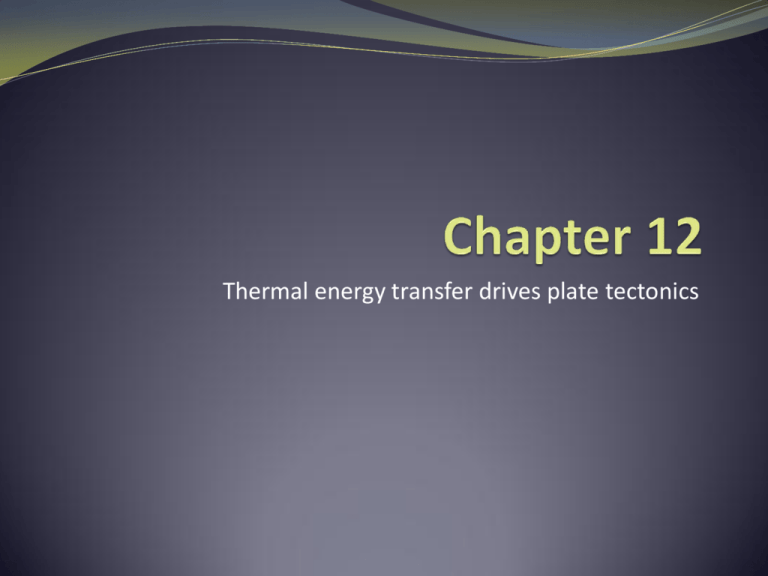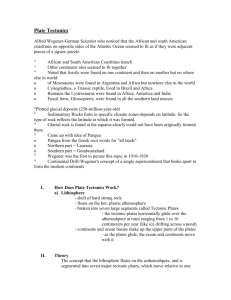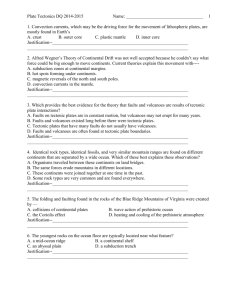Chapter 12 Plate Tectonics
advertisement

Thermal energy transfer drives plate tectonics • • • • • Various pieces of evidence indicate that the continents were once joined but later drifted to their current positions. The continental shelves of the continents can be aligned. Regions of some continents that are far apart have similar rocks, mountain ranges, fossils, and patterns of paleoglaciation. The process of sea floor spreading provides a mechanism for continental drift. The continents are attached to huge slabs of rock, known as tectonic plates. When the tectonic plates move across Earth’s surface, they carry the continents with them. The Jigsaw Puzzle Fit 1. The continental drift theory is a theory put forward by Alfred Wegener in the early 20th century that proposed that continents moved around on Earth’s surface and were at one time joined together. 2. Wegener suggested that millions of years ago the continents were joined together as a supercontinent, which he called Pangaea, meaning “all Earth.” • The shape of the continents on a world map suggests that they might fit together like jigsaw pieces. • The fit is even better when the continental shelves surrounding the continents are included. • A continental shelf is a shallow, undersea plain stretching off the coast of a continent. The Jigsaw Puzzle Fit 3. See the Geological Time chart on page 7 of your Data Pages for information on geological time, models of how Pangaea may have formed, and models of how the continents may have moved into their present positions. • Earth scientists and geologists use the geological time scale to describe the timing of and relationships between events in Earth’s past. Evidence for Continental Drift 1. Other evidence supported Wegener’s theory of continental drift. • There were matching geologic features, such as mountain ranges and rocks, on different continents. • There were matching fossils, such as Mesosaurus, on different continents representing species that could not cross oceans. • There was evidence of different climates in the past, such as coal deposits in Antarctica, which is now too cold to support plant life, and evidence of glaciers in parts of Africa, where it is now too warm for glaciers to form. • Paleoglaciation is a term describing past periods of extensive glaciations that covered most of the continents. Evidence for Continental Drift Quick Check 1. What did Wegener notice about the shapes of continents that led him to suggest that continents were able to move? 2. List three forms of evidence besides continent shape that gave support to the idea of continental drift. How Can Continents Move? A Possible Mechanism 1. Wegener’s evidence for continental drift did not explain how entire continents could change locations, so his theory was rejected by scientists of his time. 2. Wegener and the other scientists of his time did not know that Earth’s surface is broken into large, rigid, movable slabs of rock called tectonic plates that slide over a layer of partly molten rock. 3. New scientific equipment developed since the 1940s has allowed scientists to gather evidence from the sea floor. Evidence for Continental Drift 1. Evidence from mapping the sea floor • When explorers began to map the ocean floor, they discovered undersea mountain ranges. • A mountain range is a chain of mountains separated from other mountains or surrounded by lowlands. • They discovered a mid-ocean ridge, a mountain range running north to south down the length of the Atlantic Ocean, which they named the Mid-Atlantic Ridge. 2. Evidence from ocean rock and sediments • Rocks taken from the Mid-Atlantic Ridge were younger than other ocean rocks. • Sediments along the Mid-Atlantic Ridge became thicker farther away from the ridge. Evidence for Continental Drift 3. Evidence from paleomagnetism • The direction of Earth’s magnetic polarity can experience a magnetic reversal over thousands of years so that the magnetic north pole becomes the magnetic south pole and vice versa. • Paleomagnetism is the study of the magnetic properties of ancient rocks. Evidence for Continental Drift • • • Using a magnetometer, a device that detects variations in magnetic fields, researchers discovered that the rocks on either side of the MidAtlantic Ridge had a pattern of stripes in the direction that ironcontaining rocks pointed (Figure 12.1). This evidence indicated that some rocks formed when Earth’s magnetic polarity was normal and some formed when the polarity was reversed. Periods of normal polarity and reverse polarity can be detected by measuring the magnetic fields of rocks on the sea floor. Figure 12.1 Over time, the orientation of Earth’s magnetic field has reversed many times. Sea Floor Spreading 1. In 1960, American geologist Harry Hess proposed that magma rises from below Earth’s surface, then cools and hardens when it breaks through the surface at a geologic hot spot or a mid-ocean ridge (also called a spreading ridge), forming new sea floor. • A geologic hot spot is the location of excess radioactivity, causing magma to rise to Earth’s surface. • The Hawaiian Islands formed as a tectonic plate passed over a hot spot and magma rose up from under Earth’s surface. • Convection currents deep under Earth’s surface may cause new magma to rise and continuously push the old rock aside in a process called sea floor spreading. Sea Floor Spreading 2. In the mid-1960s, Canadian geologist J. Tuzo Wilson combined the concepts of sea floor spreading and paleomagnetism to explain continental drift, laying the groundwork for the plate tectonic theory. • The plate tectonic theory states that Earth’s surface is broken into large plates that move apart and then rejoin, sliding over the semi-fluid rock below. Quick Check 1. Why were Wegener’s ideas about continental drift originally rejected? 2. Explain the implications of evidence from each of the following areas. (a) mapping the sea floor (b) analyzing ocean rock and sediments (c) paleomagnetism 3. How did the Hawaiian Islands form? 4. What does the theory of plate tectonics state? • Earth has distinct layers. The asthenosphere is the partly molten layer of Earth located beneath the lithosphere. Convection currents from the asthenosphere push magma to Earth’s surface, causing tectonic plates to move and sometimes converge. • When tectonic plates converge, one plate may slide beneath the other or the edges of the plates may crumple, forming mountains. Tectonic plates can also diverge, or spread apart, forming rifts on land and ridges in the oceans. • Tectonic plates may begin to slide past one another at a transform boundary, resulting in the build-up of pressure, which may be released as an earthquake. Volcanoes occur at tectonic plate boundaries or over geologic hot spots, where magma is coming up through Earth’s crust. Tectonic Plates and A Cross-Section of Earth 1. Earth is over 1200 km thick and has four distinct layers (Figure 12.2). • Crust: outer solid rock layer • Continental crust is made from a less dense type of rock called granite. • Oceanic crust is made from a dense rock called basalt. • Mantle: thickest layer, mostly solid except for upper mantle being able to flow like “thick toothpaste” • Outer core: liquid iron and nickel • Inner core: mostly iron, the tremendous pressure keeps it solid. • Heat from Earth’s core helps produce convection currents and hot-spot activity. 2. A cross-section model of Earth. • A cross-section represents a slice of an object and shows its interior, whereas a map view shows only the Figure 12.2 A cross-section of Earth object’s surface. Plate Motion 1. Tectonic plates make up the lithosphere, which floats on the asthenosphere • The lithosphere is the crust and upper portion of the mantle. • The asthenosphere is the molten layer of the upper mantle. 2. There are about 12 major tectonic plates and many smaller ones. • Tectonic plates are all moving at the same time. Plate Motion 3. Mantle convection is thermal energy transfer in the mantle where hot, light magma rises and cold, dense lithospheric plate material sinks. • Density is the amount of mass contained in a given volume. • Heat to keep the asthenosphere molten comes from radioactive elements. • A mantle plume is an upwelling of extremely hot rock within Earth’s mantle that forms hot spots. 4. Continents, attached to the tectonic plates, float in the magma of the asthenosphere. 5. Rising magma can reach the surface at spreading ridges (in the oceans) or rift valleys (on land). • The magma cools when it reaches the surface, solidifies, and is pushed aside as new magma pushes from below. • In a process called ridge push, the spreading mid-ocean ridge pushes the rest of the tectonic plate it is on away from the ridge. Plate Motion 6. Subduction is the action of one tectonic plate pushing below another tectonic plate (Figure 12.3). • A more dense oceanic plate subducts under a lighter continental plate. • The dense, subducting plate material pulls the rest of the attached plate toward the subduction zone and down into the mantle, a process called slab pull. 7. Along with convection currents and ridge push, slab pull helps keep tectonic plates in motion. 8. A plate boundary is the location where two plates meet and move relative to each other. Figure 12.3 Thermal energy from inside Earth, gravity, and tectonic plate interactions affect the movement of tectonic plates. Quick Check 1. Name the four layers of Earth, in order from the inside out. (a) (b) (c) (d) 2. What is the difference between the densities of oceanic crust and continental crust? 3. What is the source of energy for convection currents and hot-spot activity in Earth’s mantle? 4. In terms of the crust and the mantle, describe: (a) the lithosphere (b) the asthenosphere 5. What is a mantle plume? 6. How does a rift valley form? 7. What happens in subduction? Plate Interactions Refer to your Data Pages, page 11, for the Tectonic Plate Boundaries Map. Each of the following plate boundaries and their movements are shown on the map. Notice the different symbols used to show each type of boundary on the map. 1. Divergent plate boundaries are areas where tectonic plates are spreading apart. • Ocean ridges such as the Mid-Atlantic Ridge are examples of divergent plate boundaries. • Diverging plates at the East African Rift are slowly breaking Africa into pieces. 2. Convergent plate boundaries are areas where tectonic plates collide. • A subduction zone is a zone representing a convergent plate boundary, where one tectonic plate subducts beneath and is destroyed by the other overriding tectonic plate. • Large earthquakes and volcanoes are found in subduction zones. • A trench is a long narrow depression in the ocean floor that marks a convergent plate boundary and is part of a subduction zone. Plate Interactions A. Oceanic-Continental Plate Convergence • • • The oceanic plate subducts under the continental plate, forming a trench (Figure 12.4). Cone-shaped volcanoes can form from magma seeping to the surface. A volcano is an opening in Earth’s surface that, when active, spews out gases, chunks of rock, and melted rock. Figure 12.4 The convergence of an oceanic and a continental plate produced the Coast Mountains of British Columbia. A. Oceanic-Continental Plate Convergence • • • • A volcanic belt is a long chain of volcanoes. The volcanic belt of the Pacific Northwest has formed as a result of the oceanic-continental convergence between Juan de Fuca Plate (oceanic) and the North American Plate (continental). Mountain ranges like the Coast Mountain range also form from the convergence. Earthquakes can occur when slab pull, ridge push, and subduction stall. B. Oceanic-Oceanic Plate Convergence • • The cooler, denser plate subducts under the warmer, less dense plate (Figure 12.5). Convergence may produce a volcanic island arc, which is a long chain of volcanic islands, such as those found in Japan, Indonesia, and Alaska’s Aleutian islands. Figure 12.5 The convergence of two oceanic plates can produce a volcanic island arc, such as the Aleutian Islands of Alaska, in the United States. C. Continental-Continental Plate Convergence • • • Since both plates are continental plates, their densities are similar. As they collide, their edges fold and crumple, forming mountain ranges (Figure 12.6). The Himalayas are the world’s youngest (and tallest) mountain range and are still growing taller today. Figure 12.6 The convergence of two continental plates is gradually forcing the Himalayas higher. C. Continental-Continental Plate Convergence 3. Transform plate boundaries are areas where tectonic plates slide horizontally past each other (Figure 12.7). • Transform plate boundaries are usually are found near ocean ridges but may also be found on land, such as the San Andreas Fault in California. • Since rock slides past rock, no mountains or volcanoes form, but earthquakes and faults may result. • A fault is a break or fracture in rock layers due to movement on either side. • A transform fault is a fracture zone between two offset segments of a mid-ocean ridge. Figure 12.7 Transform faults can occur when tectonic plates move alongside one another. Quick Check 1. List three kinds of plate interactions. 2. Identify the geographical features that are typical of (a) two oceanic plates converging (b) an oceanic plate and a continental plate converging (c) two continental plates converging (d) two continental plates diverging (e) two oceanic plates diverging 3. What is the relative motion that occurs between two plates that meet at a transform boundary? Earthquakes 1. An earthquake is a shaking of the ground as the result of a sudden release of energy in Earth’s crust. • Earthquakes often form as a result of friction between moving tectonic plates that works against convection currents and results in the buildup of pressure. 2. About 80 percent of earthquakes occur in a ring bordering the Pacific Ocean. • The Juan de Fuca convergent plate boundary west of Vancouver Island has many earthquakes. 3. The focus of an earthquake is where the pressure is finally released. • The epicentre is the point on the surface directly above the focus. Earthquakes 4. Earthquakes occur at various depths, depending on the plates involved (Table 12.1). • Earthquakes at the surface tend to cause more damage. Classification Depth of Focus Shallow focus 0 to 70 km Intermediate focus 70 to 300 km Deep focus Greater than 300 km Table 12.1 Classification of Earthquakes Seismic Waves 1. Energy released by an earthquake produces vibrations called seismic waves. • Seismic waves reveal the source and strength of an earthquake. • Seismic waves also help us learn about the composition and size of Earth’s interior layers since the waves behave differently in different layers. • Some seismic waves travel underground and are affected by the density of the material they travel through, which provides evidence of whether a layer is solid. 2. Primary waves (P-waves) are underground seismic waves that travel at about 6 km/s through Earth’s crust, causing the ground to move in the direction of the wave’s motion (Figure 12.8). • P-waves travel through solids, liquids, and gases. • P-waves are the fastest and are the first waves to arrive after an earthquake. Figure 12.8 Primary waves illustration Seismic Waves 3. Secondary waves (S-waves) are underground seismic waves that travel at about 3.5 km/s, causing the ground to move perpendicular to the direction of the wave’s motion (Figure 12.9). • S-waves travel through solids but not liquids. • S-waves are slower and are the second waves to arrive after an earthquake. 4. Surface waves (L-waves) are seismic waves that ripple along Earth’s surface like ripples on a pond (Figure 12.10). • L-waves usually cause more structural damage than P-waves. • L-waves are the slowest and the last waves to arrive after an earthquake. Figure 12.9 Secondary waves illustration Figure 12.10 Surface waves illustration Quick Check 1. What is the difference between the focus of an earthquake and the epicentre of an earthquake? 2. What are three kinds of earthquake waves and how do they differ? (a) (b) (c) Measuring Earthquakes 1. Seismometers or seismographs are machines that measure and record seismic wave energy. 2. A seismogram is a graph that shows the arrival times and sizes of seismic waves produced by an earthquake, showing when an earthquake started, how long it lasted, and its magnitude (strength). • An increase of 1 in magnitude = 10× stronger Example: A magnitude 6 earthquake is 100× more powerful than a magnitude 4 earthquake. 3. Since seismic waves travel at different speeds, a time-distance graph can reveal the focus (Figure 12.11). Figure 12.11 A time-distance graph shows how long it takes for different seismic waves to travel a certain distance. Volcanoes 1. The movement of tectonic plates causes volcano formation. 2. Composite volcanoes are found along plate boundaries and are made of layers of ash and lava, which is magma on Earth’s surface. • As magma reaches the surface, it cools, hardens, and traps gases below. • Pressure builds, and eventually there is an eruption. Volcanoes 3. Shield volcanoes form over hot spots. • Lava flows out from a hot spot and forms a low, wide cone. • The Hawaiian Islands are an example of a chain of shield volcanoes. • The Anaheim Volcanic Belt (see Data Pages, page 10) formed over a hot spot in the middle of British Columbia. • Yellowstone National Park in the United States has a series of volcanoes formed over a hot spot. Volcanoes 4. Rift eruptions occur along long cracks in the lithosphere, such as along the Mid-Atlantic Ridge. • These eruptions are not explosive, but they release massive amounts of lava. Quick Check 1. List three types of volcanoes and state where each is found.








